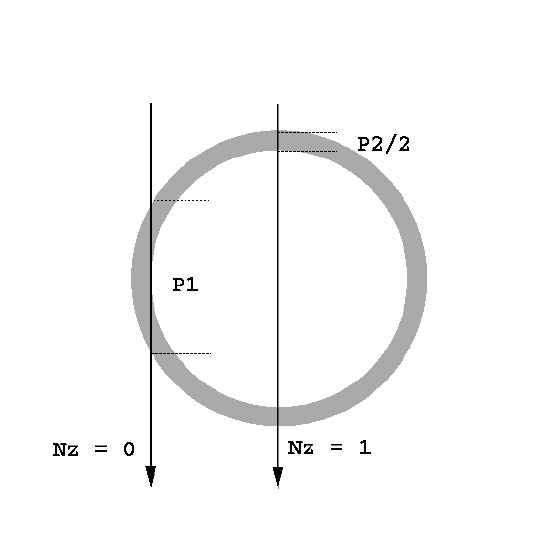T = (n1 / n2 ) L -
[ cos(thetai) + (n1/
n2)(N*L) ] N
How does this get added in to the color
calculation?
- Hall
- Add a term to the illumination equation:
I = ... + kt(N * H')n
H' = [ L - ((n1 / n2 ) V]
/(n1 / n2 ) -1]
Kay
- No refraction
- Blend background color
- -Simple version: I = tIbackground + (1 -
t)Iobject
- where t is % of transparency.
- Complex version:
Simulate a curved hollow surface ->
less transparency at edges because more material (P1 >>
P2) :

Modulated by Nz -- z-component
of normalized normal of the projected object, one has
t = tmin + (tmax - tmin)Nz
For smooth shading, go through more and more material, so raise
to a power. Final Formula:
t = tmin + (tmax - tmin)[1 - (1-Nz)P]
Only works with some hidden surface removal algorithms
How can this work with a Z-buffer algorithm?
What about specular highlights ?
-- Should wash out transparency
I = (specular of transparent surface) + (1
-t)*(ambient+diffuse of transparent surface) +
t*(rgb of background)
==> %opaque = (1-t) + %specular
How can you add refraction ?
SHADOW GENERATION
Definitions
- umbra
- portion completely hidden from light -- darkest area
- penumbra
- can partially see light
- only present with a distributed light source --
``soft shadow'' area
We will look at algorithms mainly concerned with point light sources.
Algorithms
- During scan-out: SHADOW EDGES

- pre-process to determine which polygon can shadow each
polygon.
- During scan-out:
- if no shadowing polygon, just do standard
illumination.
- if shadowing polygons
- if doesn't overlap current segment, just do normal illumination.
- if completely covers this segment, shadow it
- else, subdivide and test each area.
- tricky algorithm
- extra data structure
- uses span coherence
- depends on observer position
- lots of calculation during scan-out
- Shadow polygons (Atherton, Weiler and Greenberg 78)
- two pass algorithm
- Pass 1 calculates shadow polygons by doing
H.S.R. w.r.t. light source (Weiler-Atherton alg.).
- Pass 2 H.S.R. combined with shadow polygons. Polygons
without attached shadow polygons should be darkened.
- view independent
- object space resolution
- increases storage space for shadow polygons.
- break polygons based on shadowing information
- Shadow Volumes (Crow 77)

- common algorithm
- creates shadow volumes resulting from silhouette edges
of object and light source.
- shadow volume formed by shadow polygons. Each shadow
polygon is tagged
with the shadow volume, light sources and forward or
backward to the eye.
- during scanning each pixel
- a counter for each light initialized to 1 (if
eye in shadow) or 0 (if otherwise)
- process depth sorted polygons
- for shadow polygons
- if front, counter[l] += 1
- if back, counter[l] -= 1
- for normal polygons
- if counter[l] even,
not in shadow
- if counter[l] odd,
in shadow
Problems with shadow volumes:
- adds a lot of polygons
- non-trivial to generate shadow volume and polygons.
- need depth sort
Advantages with shadow volumes:
- independent of observer position
- efficient
- extendible to penumbra through creation of multiple
shadow volumes
- light volumes -- lights create illuminated
volumes as well as shadow volumes
- Shadow Z-buffer (image space)

Advantage
Disadvantages
- aliasing, using lots of memory
- perspective distortion
More problems with shadow maps
- point sampling gives errors
- how to integrate shadow area
- do binary decisions, then average to give % in
shadow call ``percentage closer filtering''.
- Raytraced soft shadows
- shoot multiple rays sampling the area of the light
source
- jitter rays to reduce aliasing
- Shadow tables (Kajiya 84, Ebert 90)
- Surround each object with 3D lattice. Compute
shadowing incrementally from light source -- wave
propagation.
- 3D table for each object for each light
- During scan out,
shoot ray to light and see where intersects table
which cell's face, interpolate shadow values.
- volumetric shadowing method
- Could extend to light volumes
- extend to polygons
- Fake shadows
- project object onto plane using light for perspective
point.





